Korfball drills
1 pole, 1 ball, 4 hats in a square and 9 playersThe
4 attackers stand in a square (near the hats) around the basket, the 4 defenders hold the pole with one hand. The 9th person (the declarer) stands with the ball outside the square of the hats. The attacker passes the ball to one of the attackers, the defender who stands opposite the attacker who receives the ball must run around the hat and the attackers must now score as quickly as possible. If all goes well, the attackers quickly find the person who is free, as one of the defenders has to run around the hat-trick
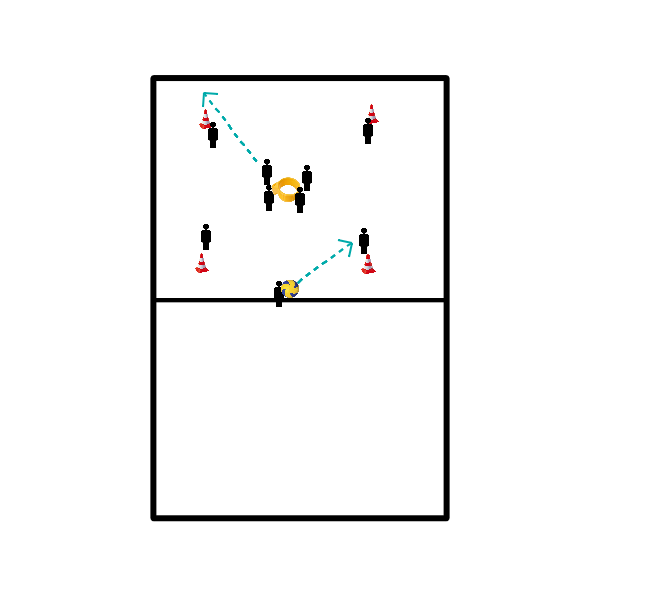
You make a square, in it stands an attacker, the attacker must keep moving in the square while a defender walks by. One person always plays the ball. The defender looks at the ball and tries to catch it. Every time the attacker catches the ball, someone else runs into the box. When the defender catches the ball, he throws it back and you try again.
The whole group walks a circle around the yellow lines in the middle in a line. When the trainer calls 'yes', the person at the back of the line starts running as fast as possible. The children do this by pulling a sprint.
Options:
The children run after each other around the yellow lines in a line. The person at the front of the line can do whatever he wants for example: heels buttocks, sprints, lifts his knees etc. Whenthe trainer calls 'yes' the person at the back of the line starts to run as fast as possible and can choose what he wants to do. It must be something other than normal running/jogging, it may be sprinting.
Children will be divided among the poles, up to three children per pole.
Pole:
Two children stay by the pole. You have a declarator and a shooter, the shooter stands near the pawn at about 3 metres distance.
The shooter has to score 4 times and then there is a rotation.
Pawns:
There are two pawns facing each other at a distance of 10 meters. The other children stand near the pawn and run back and forth. When 4 times are scored by the shooter, there is a rotation.
Rotation:
The shooter becomes the runner.
The runner becomes a catcher.
The catcher becomes the shooter.
Variation:
The distance increases from the shooter.
The runner's distance increases.
Walk-throughs, short chance, penalty throw, etc. are taken.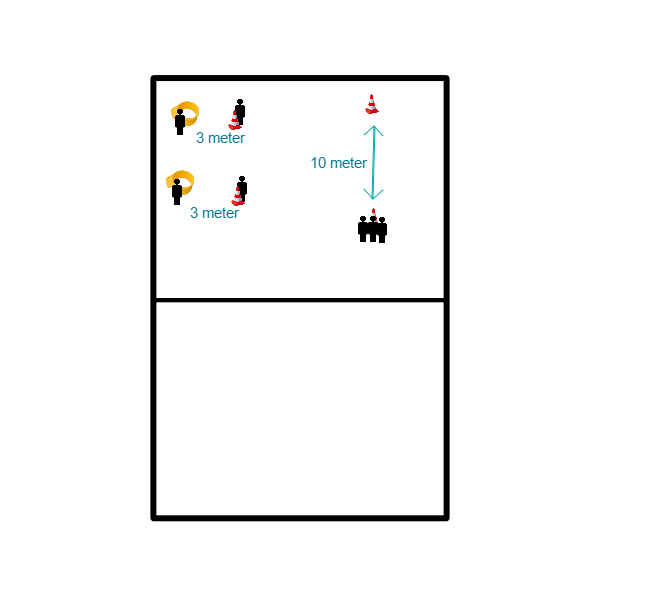
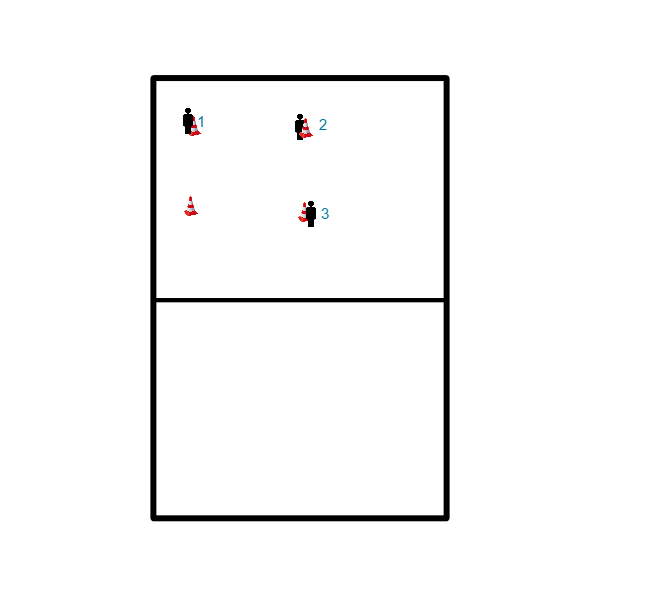 In short:
In short:
A trio has to pass the ball to each other in a square.That's tricky yes, because one is always missing....
Organisation:
Three players stand in an imaginary square about eight metres from each other. One corner remains unoccupied. The middle player (number 2) of the three has the ball.
You put four pawns in a square with a distance of 8 metres. Then you let the children make pairs. The children may take turns rolling the dice. You have three different rounds:
Round 1:
The children roll the dice. For example, if a group throws 4, each group must run 4 laps around the pawns.
Round 2:
The children first say who they are going to roll the dice for and then they get to roll passes. So they pick a group, say group 2 and roll the dice for that group.
Round 3:
The children first get to roll the dice and then they pick a group. This is almost always the most fun round. 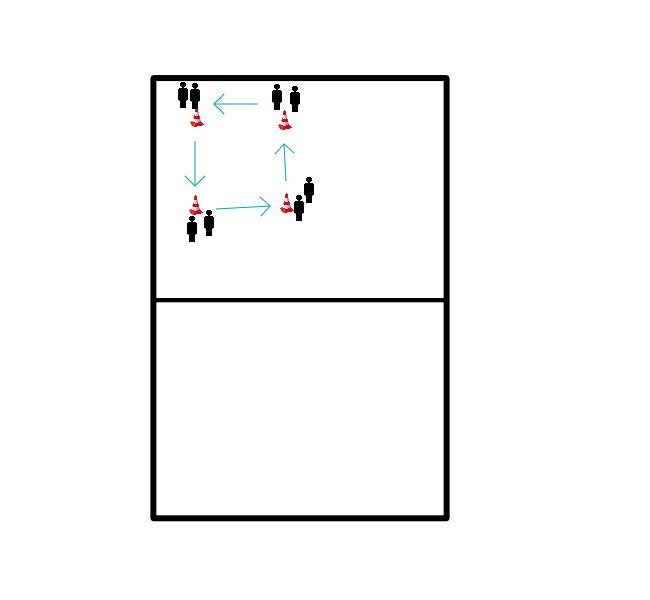
You put up three poles in a triangle, in the middle of the three poles you put a pawn. Three children are placed as attackers and the other children stand near the pawns.
First, you can choose that the attackers have to run through the poles. It doesn't matter which pole they hit, they can hit the same pole twice in a row. You can choose for this, so they have to run a lot. Also the children have to score 2 times, the person who scores first can trade with a declarator, the other children can trade with a declarator.
After that you can choose to letthe children do free balls, penalty throws, foul balls etc.
Everyone lies down on the floor like a plank, supporting themselves on their elbows with their legs extended. Then the children jump up and stretch all the way.
The whole group walks a circle around the yellow lines in the middle in a line. When the trainer calls 'yes', the person at the back of the line starts running as fast as possible. The children do this by pulling a sprint.
Options:
The children run after each other around the yellow lines in a line. The person at the front of the line can do whatever he wants for example: heels buttocks, sprints, lifts his knees etc. Whenthe trainer calls 'yes' the person at the back of the line starts to run as fast as possible and can choose what he wants to do. It must be something other than normal running/jogging, it may be sprinting.
Korfball in 1 section. An attacking and a defending side, preferably 4 against 4, possibly with substitutes.
The attacking side puts the ball in play and tries to score a goal. After scoring or intercepting, the defending side attacks.
In the first case, the ball is taken out about 15 m. in front of the basket, in the second case it is first combined to this starting point.
The attacking side may try to intercept after losing the ball. If this is successful before the ball has been played to the starting point, then a goal opportunity may be played directly.
Note:
Emphasis is on playing the ball out well and defending consistently.
Variation:
After a goal, the attacking side keeps the attacking position. The team plays 2 minutes on ball possession. If the team succeeds in keeping the ball in the team for that long, or in scoring another goal, the goal is valid. If the defence intercepts the ball, the point is forfeited.
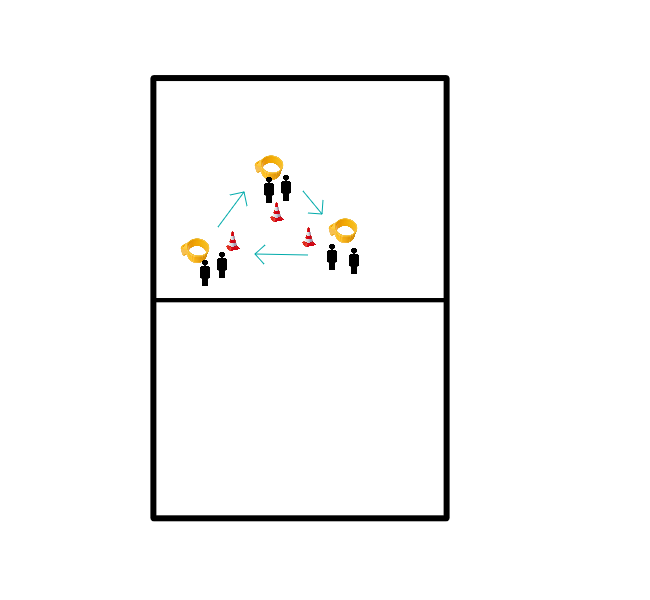 You have a pair at each pole, so the amount of poles depends on the size of the group. Everyone starts with scoring twice on the pole, when they have done this they go to the next pole. It can happen that two groups are standing at the same pole, this is because they don't all have to turn. The pairs only have to pass when they have scored twice.
You have a pair at each pole, so the amount of poles depends on the size of the group. Everyone starts with scoring twice on the pole, when they have done this they go to the next pole. It can happen that two groups are standing at the same pole, this is because they don't all have to turn. The pairs only have to pass when they have scored twice.
Place a pawn in front of the pole at a good distance for your team.
You make a square, in it stands an attacker, the attacker must keep moving in the square while a defender walks by. 1 person always plays the ball. The defender looks at the ball and tries to catch it. Every time the attacker catches the ball, someone else comes into the box. When the defender catches the ball, he throws it back and you try again.








